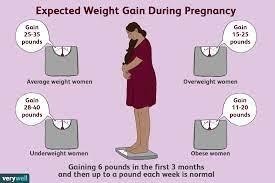A nurse is caring for a client at the first prenatal visit who has a BMI of 26.5. The client asks how much weight she should gain during pregnancy. Which of the following responses should the nurse make?
"A gain of about 1 pound per week is the best pattern for you."
"It would be best if you gained about 11 to 20 pounds."
"The recommendation for you is about 15 to 25 pounds."
"A gain of about 25 to 35 pounds is recommended for you."
The Correct Answer is C
Choice A: A weight gain of about 1 pound per week is a general guideline for women with normal BMI. However, for a client with a BMI of 26.5, the recommended weight gain during pregnancy may differ.
Choice B: Gaining 11 to 20 pounds may not be sufficient for a client with a BMI of 26.5, as the recommended weight gain is slightly higher for women with a higher prepregnancy BMI.
Choice C: For a client with a BMI of 26.5, the recommended weight gain during pregnancy is approximately 15 to 25 pounds. This range is specific to women with a BMI in the overweight category.
Choice D: Gaining 25 to 35 pounds is recommended for clients with a lower BMI range (normal BMI). For a client with a BMI of 26.5, this amount of weight gain may be excessive.

Nursing Test Bank
Naxlex Comprehensive Predictor Exams
Related Questions
Correct Answer is B
Explanation
A) The largest fetal diameter has passed through the pelvic outlet: This is an incorrect
interpretation of station 0. Station 0 means that the presenting part is at the level of the ischial spines, not fully descended through the pelvic outlet.
B) The lowermost portion of the presenting part is at the level of the ischial spines: This is the correct interpretation of station 0. Station 0 is the landmark at which the presenting part is at the level of the ischial spines in the maternal pelvis.
C) The posterior fontanel is palpable: The position of the fontanelle is not related to the station of the presenting part.
D) The fetal head is in the left occiput posterior position: The position of the fetal head is not indicated by the station measurement.
Correct Answer is D
Explanation
Choice D: Leopold maneuvers are used to determine the fetal position and presentation by palpating the abdomen. ROA stands for Right Occiput Anterior, which means the baby's head is presenting and facing towards the mother's right side (Occiput) and positioned anteriorly (front of the pelvis).
This position is a common and favorable presentation for a vaginal delivery.
Choice A: Shoulder presentation is when the baby is presenting with the shoulder rather than the head. It is an abnormal presentation and requires a cesarean delivery.
Choice B: Mentum presentation is a type of face presentation, where the baby's chin (mentum) is presenting instead of the head. It is also an abnormal presentation and usually requires a cesarean delivery.
Choice C: Breech presentation is when the baby's buttocks or feet are presenting first instead of the head. It is another abnormal presentation that may require a cesarean delivery or careful vaginal delivery with a skilled healthcare provider.
Whether you are a student looking to ace your exams or a practicing nurse seeking to enhance your expertise , our nursing education contents will empower you with the confidence and competence to make a difference in the lives of patients and become a respected leader in the healthcare field.
Visit Naxlex, invest in your future and unlock endless possibilities with our unparalleled nursing education contents today
Report Wrong Answer on the Current Question
Do you disagree with the answer? If yes, what is your expected answer? Explain.
Kindly be descriptive with the issue you are facing.
